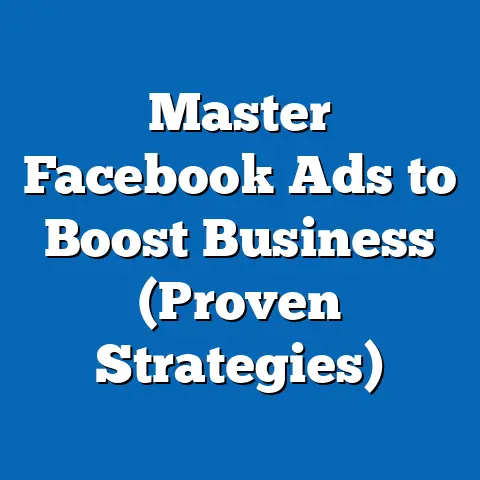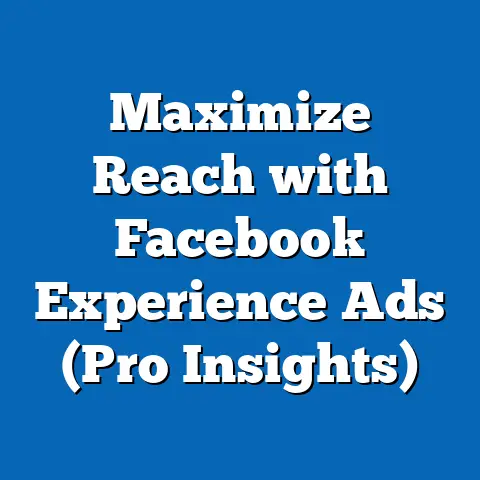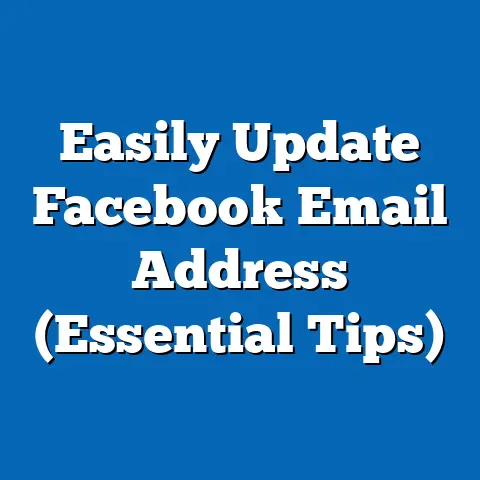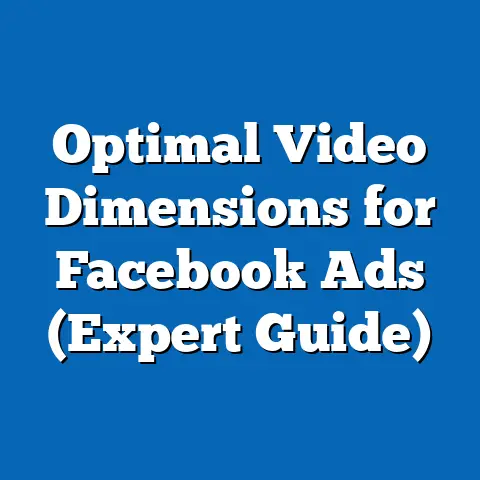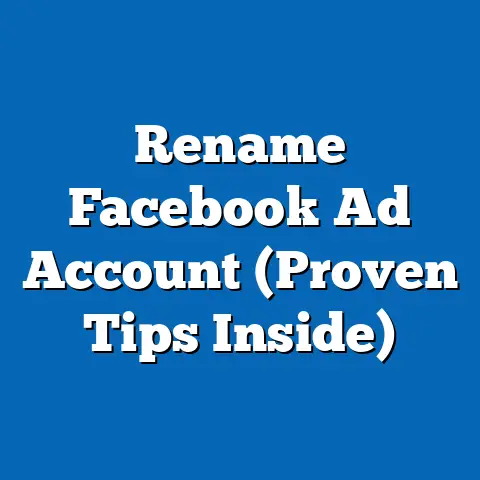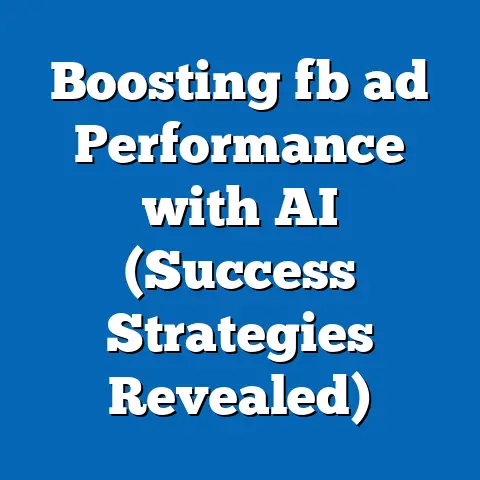Clicks vs. Link Clicks in Facebook Ads (Optimize Strategy)
Facebook advertising. It’s a powerhouse. A digital landscape where businesses can connect with billions of potential customers. Over the years, I’ve seen firsthand how mastering Facebook Ads can transform a small business, catapulting it from obscurity to significant market presence. But here’s the thing: simply throwing money at ads isn’t enough. You need to understand the nuances, the subtle differences that can make or break your campaign. And one of the most critical distinctions to grasp? The difference between clicks and link clicks.
The digital advertising landscape is booming. According to Statista, global digital ad spending is projected to reach over $600 billion in 2024, with social media advertising accounting for a significant portion of that. This massive investment underscores the importance of understanding how to make every dollar count.
Think of it this way: imagine you’re running a store. Foot traffic is great, but what you really want is people walking through the door, engaging with your products, and ultimately, making a purchase. In the world of Facebook Ads, clicks are like that general foot traffic – it shows interest, but it doesn’t guarantee a sale. Link clicks, on the other hand, are the people walking through your door, ready to explore what you have to offer.
In this article, I’ll delve deep into the world of Facebook Ads, dissecting the difference between clicks and link clicks, and providing you with actionable strategies to optimize your campaigns for maximum impact. By understanding these metrics, you can transform your ad spend into a powerful engine for growth and engagement.
Section 1: Understanding Clicks in Facebook Ads
So, what exactly do we mean when we talk about “clicks” in Facebook Ads? It’s not as straightforward as it might seem. “Clicks” is an umbrella term encompassing various types of interactions a user can have with your ad.
- Ad Clicks: This is the broadest category and includes any click on your ad. This could be a click on the image, video, headline, or any other element within the ad itself.
- Page Likes: If your ad promotes your Facebook Page, a click to “like” the page counts as a click.
- Comment Clicks: When someone clicks to leave a comment on your ad, that’s registered as a click.
- Share Clicks: Similarly, clicking to share your ad with their network is also counted as a click.
- Engagement Clicks: This includes clicks that expand the ad to show more content, such as clicking “See More” on a longer text post.
Clicks are important because they provide a general indication of how engaging your ad is. A high number of clicks suggests that your ad is capturing attention and resonating with your target audience. It’s a sign that your creative elements – your visuals, your headline, your ad copy – are doing their job in grabbing the user’s interest.
However, it’s crucial to understand that clicks don’t always translate to meaningful actions. Let’s say you’re running an ad for a new e-commerce store. A user might click on the ad simply because they like the image, or they might click “See More” to read the full text. These clicks show engagement, but they don’t necessarily mean the user is interested in visiting your website or making a purchase.
Examples of Ad Formats that Generate Clicks:
- Image Ads: These are the simplest form of Facebook Ads, featuring a single image and accompanying text. Clicks can occur on the image itself, the headline, or the call-to-action button.
- Video Ads: Video ads tend to generate a lot of clicks, as users often click to play the video or to unmute the audio.
- Carousel Ads: Carousel ads allow you to showcase multiple images or videos in a single ad unit. Users can click on each individual card in the carousel, generating multiple clicks from a single user.
Takeaway: Clicks are a valuable metric for measuring overall ad engagement, but they don’t always indicate a user’s intent to take a specific action. You need to dig deeper to understand the true value of your ad spend.
Section 2: What Are Link Clicks?
Now, let’s talk about link clicks. Unlike general clicks, link clicks are much more specific and, in many cases, more valuable.
Definition: A link click occurs when a user clicks on a specific link within your ad that directs them to a destination outside of Facebook. This could be your website, a landing page, or any other external URL.
The key difference between link clicks and general clicks is the intent. A link click demonstrates a user’s clear intention to leave Facebook and visit your designated destination. They’re actively choosing to learn more about your product, service, or offer.
Link clicks are often more valuable because they represent a direct interaction with your call to action (CTA). Your CTA is the prompt that encourages users to take a specific action, such as “Shop Now,” “Learn More,” or “Sign Up.” When a user clicks on a link associated with your CTA, they’re essentially responding to your invitation and taking the next step in the customer journey.
Scenarios Where Link Clicks Are Essential:
- Driving Traffic to a Landing Page: If your goal is to generate leads or drive sales through a dedicated landing page, link clicks are the most crucial metric to track.
- Promoting a Blog Post: If you’re using Facebook Ads to promote your blog content, link clicks will tell you how many people are actually visiting your website to read your articles.
- Directing Users to an E-commerce Store: For e-commerce businesses, link clicks are a direct indicator of how many people are interested in browsing your product catalog and potentially making a purchase.
Real-World Examples:
I once worked with a local restaurant that was struggling to attract new customers. We launched a Facebook Ad campaign promoting a special discount for first-time orders. The ad featured a mouthwatering image of their signature dish and a clear CTA: “Order Now & Get 20% Off!” We carefully tracked link clicks and saw a direct correlation between the number of link clicks and the number of new orders placed on their website. By focusing on link clicks, we were able to measure the effectiveness of the campaign and optimize our targeting and messaging to drive even more traffic to their online ordering platform.
Another example involved a software company that was launching a free trial of their product. Their initial ad campaign generated a lot of clicks, but very few people were actually signing up for the trial. After analyzing the data, we realized that most of the clicks were on the ad image, not on the “Start Free Trial” button. We redesigned the ad to make the CTA more prominent and compelling, and we saw a significant increase in link clicks and, more importantly, in free trial sign-ups.
Takeaway: Link clicks represent a more qualified audience than general clicks. They indicate a user’s specific interest in learning more about your offer and taking the next step in the customer journey.
Section 3: The Importance of Tracking Both Metrics
So, if link clicks are so valuable, why bother tracking general clicks at all? The truth is, both metrics play a crucial role in understanding the overall performance of your Facebook Ads.
Tracking both clicks and link clicks provides deeper insights into user behavior and ad effectiveness. Think of it as looking at two different pieces of the puzzle.
- Clicks provide a broad overview of ad engagement. They tell you how many people are interacting with your ad in some way, whether it’s liking, commenting, sharing, or clicking to see more.
- Link clicks provide a more specific measure of conversion potential. They tell you how many people are actively interested in visiting your website or landing page and taking the next step.
By analyzing both metrics, you can identify potential bottlenecks in your ad funnel. For example, if you’re seeing a high number of clicks but a low number of link clicks, it could indicate that your ad is capturing attention but failing to effectively drive traffic to your desired destination. This could be due to a misleading headline, a confusing call to action, or a disconnect between your ad and your landing page.
Data and Research:
Facebook’s own internal data consistently shows that ads with a clear and compelling call to action, optimized for link clicks, tend to perform better in terms of driving conversions and achieving business goals. A study by HubSpot found that businesses that prioritize link clicks in their ad campaigns see an average of 2x higher ROI compared to those that focus solely on general clicks.
Setting Up Tracking in Facebook Ads Manager:
Fortunately, tracking both clicks and link clicks in Facebook Ads Manager is relatively straightforward.
- Go to your Ads Manager dashboard.
- Select the ad campaign you want to analyze.
- Choose the “Columns” option and customize your view.
- Add “Clicks (All)” and “Link Clicks” to your selected columns.
By adding these columns, you’ll be able to see both metrics side-by-side in your Ads Manager dashboard. You can then analyze the data to identify trends, patterns, and areas for improvement.
Takeaway: Tracking both clicks and link clicks allows you to gain a comprehensive understanding of your ad performance. By analyzing the relationship between these two metrics, you can identify areas for optimization and improve your overall ROI.
Section 4: Optimizing Facebook Ad Strategies Based on Clicks vs. Link Clicks
Now for the fun part: how to actually use this knowledge to improve your Facebook Ad campaigns. Here are some key strategies for optimizing your ads based on the nuances between clicks and link clicks:
-
Tailor Ad Content and CTAs:
- High Clicks, Low Link Clicks: If you’re seeing a lot of clicks but not many link clicks, your ad might be engaging but not effectively driving traffic to your website. Try refining your call to action to be more specific and compelling. For example, instead of “Learn More,” try “Shop Now & Get Free Shipping!”
- Low Clicks, Low Link Clicks: If you’re seeing low numbers across the board, your ad might not be capturing enough attention. Try experimenting with different visuals, headlines, and targeting options.
-
Optimize Your Landing Page:
-
High Link Clicks, Low Conversions: If you’re getting a lot of link clicks but not many conversions on your website, your landing page might be the problem. Make sure your landing page is relevant to your ad, easy to navigate, and optimized for conversions.
-
A/B Testing:
-
A/B testing is a powerful tool for fine-tuning your ads based on data. Try creating two versions of your ad with different headlines, visuals, or CTAs. Run both ads simultaneously and track the performance of each. The ad with the higher link click rate is the winner.
-
Use Visuals That Entice Link Clicks:
-
Your visual should not only be eye-catching but also clearly communicate the value of clicking the link. Consider using images or videos that showcase your product or service in action, or that create a sense of urgency or excitement.
-
Targeting is Key:
-
Make sure you’re targeting the right audience with your ads. The more relevant your ad is to the user, the more likely they are to click on the link.
Tailor Ad Content and CTAs:
- High Clicks, Low Link Clicks: If you’re seeing a lot of clicks but not many link clicks, your ad might be engaging but not effectively driving traffic to your website. Try refining your call to action to be more specific and compelling. For example, instead of “Learn More,” try “Shop Now & Get Free Shipping!”
- Low Clicks, Low Link Clicks: If you’re seeing low numbers across the board, your ad might not be capturing enough attention. Try experimenting with different visuals, headlines, and targeting options.
-
Optimize Your Landing Page:
-
High Link Clicks, Low Conversions: If you’re getting a lot of link clicks but not many conversions on your website, your landing page might be the problem. Make sure your landing page is relevant to your ad, easy to navigate, and optimized for conversions.
-
A/B Testing:
-
A/B testing is a powerful tool for fine-tuning your ads based on data. Try creating two versions of your ad with different headlines, visuals, or CTAs. Run both ads simultaneously and track the performance of each. The ad with the higher link click rate is the winner.
-
Use Visuals That Entice Link Clicks:
-
Your visual should not only be eye-catching but also clearly communicate the value of clicking the link. Consider using images or videos that showcase your product or service in action, or that create a sense of urgency or excitement.
-
Targeting is Key:
-
Make sure you’re targeting the right audience with your ads. The more relevant your ad is to the user, the more likely they are to click on the link.
Optimize Your Landing Page:
High Link Clicks, Low Conversions: If you’re getting a lot of link clicks but not many conversions on your website, your landing page might be the problem. Make sure your landing page is relevant to your ad, easy to navigate, and optimized for conversions.
A/B Testing:
A/B testing is a powerful tool for fine-tuning your ads based on data. Try creating two versions of your ad with different headlines, visuals, or CTAs. Run both ads simultaneously and track the performance of each. The ad with the higher link click rate is the winner.
Use Visuals That Entice Link Clicks:
Your visual should not only be eye-catching but also clearly communicate the value of clicking the link. Consider using images or videos that showcase your product or service in action, or that create a sense of urgency or excitement.
Targeting is Key:
Make sure you’re targeting the right audience with your ads. The more relevant your ad is to the user, the more likely they are to click on the link.
Actionable Tips:
- Use strong action verbs in your CTAs: “Shop Now,” “Sign Up Today,” “Download Now.”
- Create a sense of urgency: “Limited Time Offer,” “Sale Ends Soon.”
- Highlight the benefits of clicking the link: “Get Free Shipping,” “Save 20%,” “Learn the Secrets.”
- Make your CTA button stand out: Use a contrasting color and a clear, easy-to-read font.
- Ensure your landing page is mobile-friendly: A significant portion of Facebook users access the platform on their mobile devices.
Insights from My Experience:
I remember working with a clothing retailer whose ads were generating a lot of clicks, but their website traffic was surprisingly low. After digging into the data, we discovered that most of the clicks were coming from mobile users, but their website wasn’t optimized for mobile viewing. The website was slow to load, difficult to navigate, and the checkout process was cumbersome. As a result, many users were clicking on the ad but quickly abandoning the website once they realized it wasn’t a good mobile experience.
We immediately prioritized optimizing their website for mobile devices. We improved the loading speed, simplified the navigation, and streamlined the checkout process. As a result, we saw a significant increase in website traffic and, more importantly, in mobile conversions. This experience taught me the importance of considering the entire customer journey, from the initial ad click to the final purchase.
Takeaway: By understanding the nuances between clicks and link clicks and implementing these optimization strategies, you can significantly improve the performance of your Facebook Ad campaigns and drive more meaningful results for your business.
Conclusion
Understanding the difference between clicks and link clicks is crucial for optimizing Facebook ad strategies. Clicks offer a broad view of engagement, while link clicks pinpoint users ready to take action. By tracking both, you gain deeper insights, allowing for refined ad content, CTAs, and landing pages. A/B testing further fine-tunes your approach, and targeting ensures relevance.
As you become more adept at analyzing these metrics, you’ll unlock significant growth and engagement opportunities in your Facebook ad campaigns. The key is to be data-driven, constantly testing and refining your approach based on the results you see. With a little bit of effort and a keen eye for detail, you can transform your Facebook Ads into a powerful engine for business growth.

